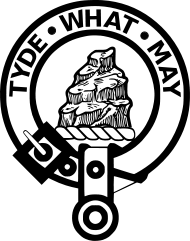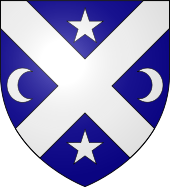- Clan Haig
-
Crest badge 
Profile Chief

Alexander Haig Chief of Clan Haig, The Rt. Hon. 3rd Earl Haig Clan Haig is a Lowland Scottish clan.
Contents
History
Origins
The name 'Haig' comes from the Norman name 'de Haga'. There were theories that the Haigs were of Pictish descent but this has been discounted. A charter signed in 1162 to Dryburgh Abbey bears the name 'Petrus de Haga, proprietor of the lands and barony of Bemersyde'. He was later charged by Alexander II of Scotland with the murder of the Earl of Athol at Haddington in 1192. The Barons of Bemersyde rapidly gained a position of some influence in the area and its not surprising to see their signature among the other Scottish nobles on the Ragman Rolls in 1296. Like so many others who signed this document swearing fealty to Edward I of England they were soon to join the cause of Scottish Independence.
Wars of Scottish Independence
In the late 13th century and early 14th century during the Wars of Scottish Independence the Clan Haig fought alongside William Wallace against the English at the Battle of Stirling Bridge in 1296. The sixth Laird continued this loyalty to the Scottish cause by fighting alongside Robert the Bruce at the Battle of Bannockburn at the age of only seventeen. He continued to support Scottish independence, falling at the Battle of Halidon Hill in 1333.
15th century & clan conflicts
Chief Gilbert Haig opposed the powerful Clan Douglas. Gilbert's son James supported King James III of Scotland. After the King was murdered in 1488 he fled into hiding before making peace with King James IV of Scotland.
16th century & Anglo-Scottish Wars
During the Anglo-Scottish Wars, chief William Haig led the Clan Haig at the Battle of Flodden Field, where he was killed in 1513.
His son, the 14th Laird of Bemerside was able to effect some revenge for his father's death when he captured Lord Evers, an English commander at the Battle of Ancrum Moor in 1544. Evers later died at Bemerside and was buried at Melrose Abbey.
17th century
Chief William Haig, the 19th Laird was the King's Solicitor for Scotland during the reigns of James VI and Charles I of England. The twenty-first Laird, Anthony Haig was persecuted for his membership of the Society of Friends and suffered a long period of imprisonment.
Four sons of the chief were killed while fighting in the service of the King of Bohemia between 1629 and 1630.
19th century
In the nineteenth century the line of succession looked to be in danger when the succession fell to three unmarried daughters. However they signed a deed before their death that transferred the succession to a cousin; Colonel Arthur Balfour Haig, a descendant of the seventeenth Laird. Their cousin became the twenty eighth laird.
Tower of Bemersyde
The ancestral seat of the Haigs, Bemersyde House was originally built in 1535 when its principle purpose was defense. It was improved in 1690 when large windows and fireplaces were introduced. The house was extended in the eighteenth and nineteenth centuries. In 1960 further alterations were carried out by George Haig, 2nd Earl Haig to improve the overall design and proportions of the house.
Remarkably the lands of Bemersyde have stayed in the possession of the Haig family for eight hundred years. A fact predicted in the thirteenth century by Thomas the Rhymer who said 'Tyde what may, what’er betyde, Haig shall be Haig of Bemersyde’.
Clan chief
The current chief of Clan Haig is Alexander Haig, 3rd Earl Haig (b. 1961), grandson of Field Marshal Douglas Haig, 1st Earl Haig of First World War fame.
See also
External links
- http://www.scotclans.com/clans/Haig/history.html
- http://www.myclan.com/clans/Haig_46/default.php
- http://www.electricscotland.com/webclans/htol/haig2.html
Scottish clans Clans with chiefs Agnew · Anstruther · Arbuthnott · Arthur · Bannerman · Barclay · Borthwick · Boyd · Boyle · Brodie · Broun · Bruce · Buchan · Burnett · Cameron · Campbell · Carmichael · Carnegie · Cathcart · Charteris · Chattan · Chisholm · Cochrane · Colquhoun · Colville · Cranstoun · Crichton · Cumming · Darroch · Davidson · Dewar · Drummond · Dunbar · Dundas · Durie · Elliot · Elphinstone · Erskine · Farquharson · Fergusson · Forbes · Forsyth · Fraser · Fraser of Lovat · Gayre · Gordon · Graham · Grant · Gregor · Grierson · Guthrie · Haig · Haldane · Hamilton · Hannay · Hay · Henderson · Home · Hope · Hunter · Irvine · Jardine · Johnstone · Keith · Kennedy · Kerr · Kincaid · Lamont · Leask · Lennox · Leslie · Lindsay · Lockhart · Lumsden · Lyon · MacAlister · MacBain · MacDonald · Macdonald of Clanranald · MacDonald of Keppoch · Macdonald of Sleat · MacDonell of Glengarry · MacDougall · Macdowall · MacIntyre · Mackay · Mackenzie · Mackinnon · Mackintosh · Maclachlan · Maclaine of Lochbuie · MacLaren · MacLea (Livingstone) · Maclean · MacLennan · MacLeod · MacLeod of Lewis · MacMillan · Macnab · Macnaghten · MacNeacail · MacNeil · Macpherson · MacTavish · MacThomas · Maitland · Makgill · Malcolm (MacCallum) · Mar · Marjoribanks · Matheson · Menzies · Moffat · Moncreiffe · Montgomery · Morrison · Munro · Murray · Napier · Nesbitt · Nicolson · Ogilvy · Oliphant · Primrose · Ramsay · Rattray · Riddell · Robertson · Rollo · Rose · Ross · Ruthven · Sandilands · Scott · Scrymgeour · Sempill · Shaw · Sinclair · Skene · Spens · Stirling · Strange · Stuart of Bute · Sutherland · Swinton · Trotter · Urquhart · Wallace · Wedderburn · Wemyss · Wood ·
Armigerous clans Abercromby · Abernethy · Adair · Adam · Aikenhead · Ainslie · Aiton · Allardice · Anderson · Armstrong · Arnott · Auchinleck · Baillie · Baird · Balfour · Bannatyne · Baxter · Bell · Belshes · Bethune · Beveridge · Binning · Bissett · Blackadder · Blackstock · Blair · Blane · Blyth · Boswell · Brisbane · Buchanan · Butter · Byres · Cairns · Calder · Caldwell · Callender · Campbell of Breadalbane · Campbell of Cawdor · Carruthers · Cheyne · Chalmers · Clelland · Clephane · Cockburn · Congilton · Craig · Crawford · Crosbie · Cunningham · Dalmahoy · Dalrymple · Dalzell · Dennistoun · Don · Douglas · Duncan · Dunlop · Edmonstone · Fairlie · Falconer · Fenton · Fleming · Fletcher · Forrester · Fotheringham · Fullarton · Galbraith · Galloway · Gardyne · Gartshore · Ged · Gibsone · Gladstains · Glas · Glen · Glendinning · Gray · Gunn · Haliburton · Halkerston · Halket · Hepburn · Heron · Herries · Hogg · Hopkirk · Horsburgh · Houston · Hutton · Inglis · Innes · Kelly · Kinloch · Kinnaird · Kinnear · Kinninmont · Kirkcaldy · Kirkpatrick · Laing · Lammie · Langlands · Learmonth · Little · Logan · Logie · Lundin · Lyle · MacAulay · Macbrayne · MacDuff · MacEwen · MacFarlane · Macfie · Macgillivray · MacInnes · MacIver · Mackie · MacLellan · Macquarrie · Macqueen · Macrae · Masterton · Maule · Maxton · Maxwell · McCorquodale · McCulloch · McKerrell · Meldrum · Melville · Mercer · Middleton · Moncur · Monteith · Monypenny · Mouat · Moubray · Mow · Muir · Murray of Atholl · Nairn · Nevoy · Newlands · Newton · Norvel · Ochterlony · Orrock · Paisley · Paterson · Pennycook · Pentland · Peter · Pitblado · Pitcairn · Pollock · Polwarth · Porterfield · Preston · Pringle · Purves · Rait · Ralston · Renton · Roberton · Rossie · Russell · Rutherford · Schaw · Seton · Skirving · Somerville · Spalding · Spottiswood · Stewart · Stewart of Appin · Strachan · Straiton · Strange · Sydserf · Symmers · Tailyour · Tait · Tennant · Troup · Turnbull · Tweedie · Udny · Vans · Walkinshaw · Wardlaw · Watson · Wauchope · Weir · Whitefoord · Whitelaw · Wishart · Young
Culture and society Scotland · Clan chief · Septs · Clan badge · Clan crest · Clan battles · Tartan · Bagpipes · Clearances · Kilt · Manrent · The Highlands · Battle of Culloden · Highland games · Border Reivers · Scottish heraldry · Scottish surnames
Categories:- Scottish clans
Wikimedia Foundation. 2010.
